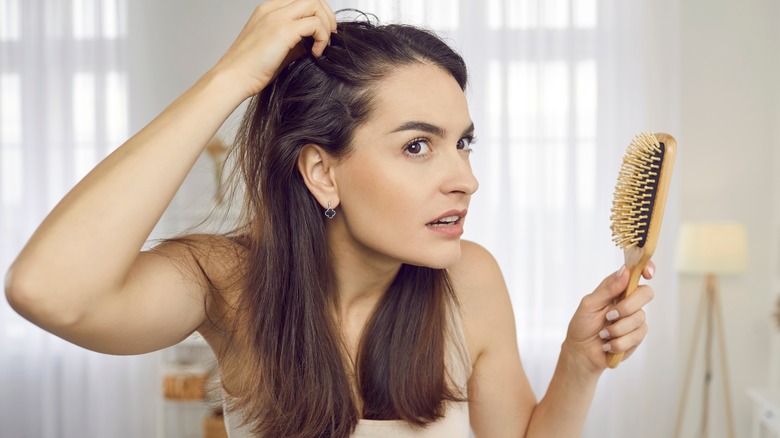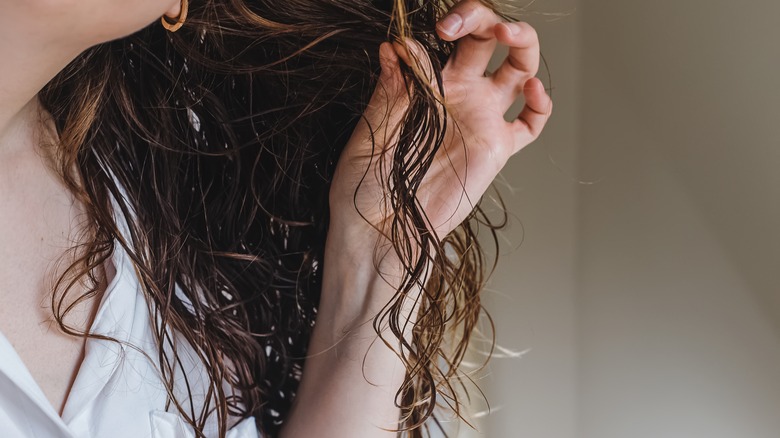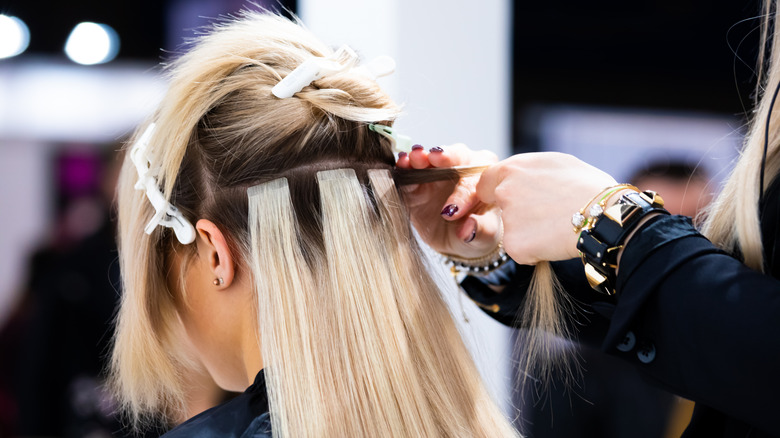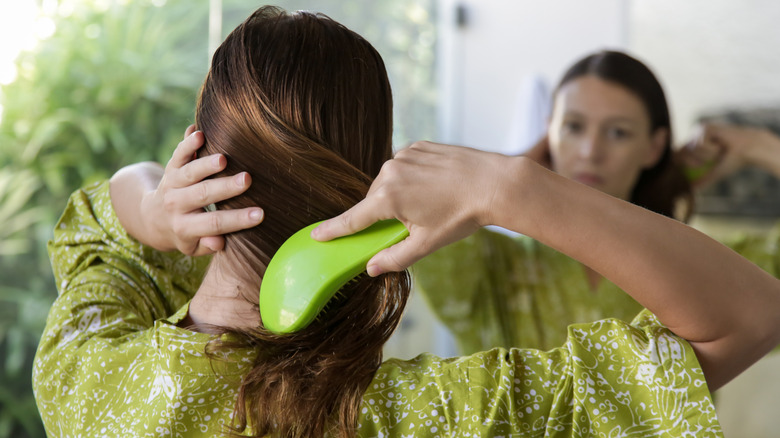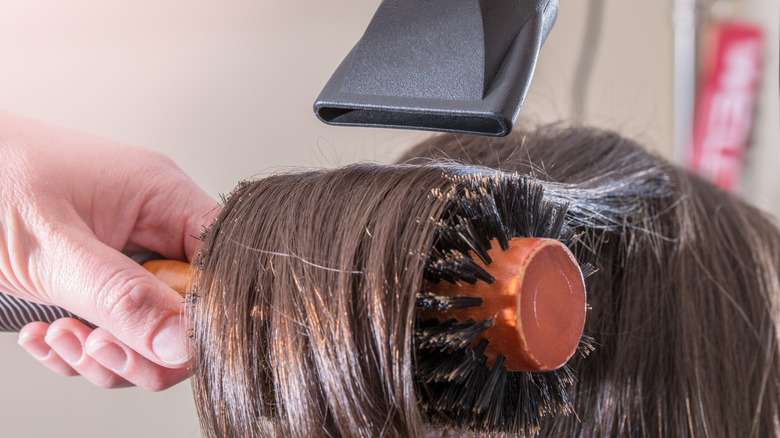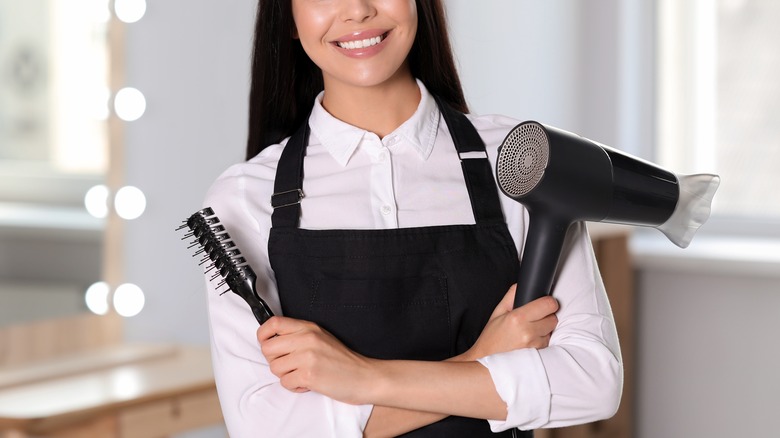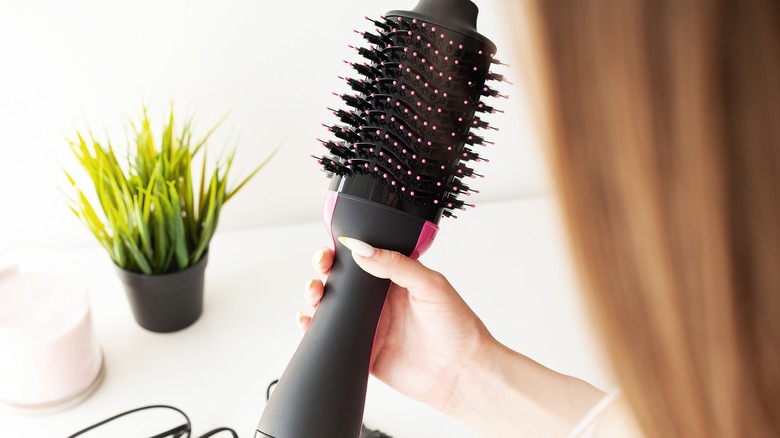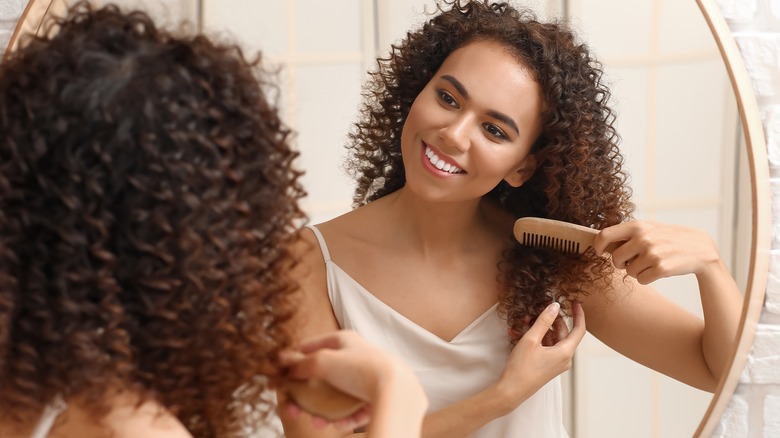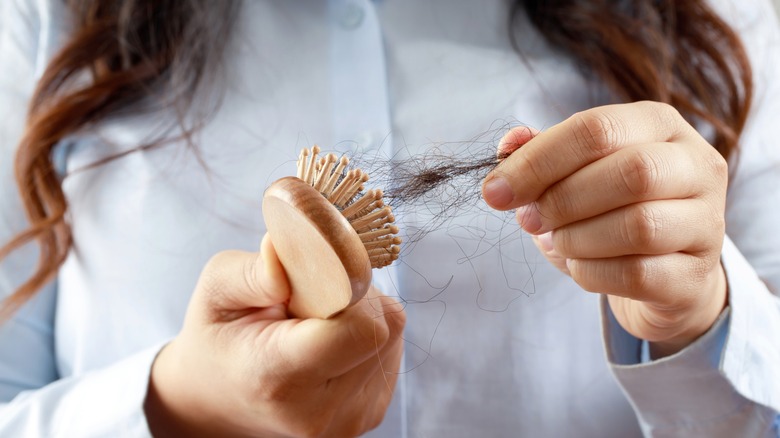Brush Vs. Comb: Which Is Actually Right For Your Hair?
Just in case you haven't popped into the hair care section of your favorite beauty haunt lately, we can confirm: The number of different products, brushes, combs, and tools available is as staggering as ever. Even if you're only looking to do something as simple as replace your old hairbrush, it can be difficult to know what's best for your hair. Round, paddle, vented, thermal, soft bristle, stiff bristle, boar hair ... the options are endless, and what you choose can have lasting consequences for your hair, good or bad. So, which one is actually right for your hair? The honest answer is that it depends on a number of factors, such as your hair type, the condition of your hair, and even the style you're going for.
According to Healthline, regular brushing (or combing) is essential to keeping your hair healthy and looking its best. Aside from detangling those dreaded knots, daily brushing removes loose hairs, stimulates the scalp, and helps to distribute your skin's natural oils down the hair shaft, adding shine while also fighting dryness and split ends.
However, using the wrong brush or comb can actually end up damaging your hair, leading to breakage, frizz, split ends, and more. Clearly, the task of choosing your next brush or comb isn't as mundane as it seems. So before you make any decisions, it's certainly worth it to stop and consider the needs of your individual mane.
Determine your hair type
Per Healthline, there are four basic hair types based on the amount of curl in a person's locks, which can then be broken down further into subtypes based on texture and other factors. Each hair type has unique characteristics that require equally unique considerations regarding care. And the good news is that you can easily determine your hair type with nothing more than a mirror.
Type 1 hair is straight from root to tip, with no natural curl, and can be fine, thick, coarse, or thin. If you have this hair type, chances are that your biggest frustrations are oiliness and lack of volume. Type 2 hair is wavy, with subtypes depending on the strength, shape, and where the waves begin on the hair shaft. A common complaint of type 2 hair is frizz. Type 3 hair is characterized by varying degrees of full-on curls, and is usually prone to dryness and breakage, while type 4 hair takes it up a notch into coily territory. Type 4 is the most delicate of all hair types, meaning that preventing breakage is probably your number one priority. Once you've figured out which of the four basic types your tresses fall under, you can more easily consider what your hair needs out of its go-to brush or comb.
Best tools for type 1 hair
Probably one of the easiest hair types to identify, type 1 hair is completely straight from root to tip. It features no natural wave or curl, and likely tends to fall pretty flat, even delving into stringy territory when wash day is approaching. Excessive oiliness is also a classic type 1 hair problem; people with this hair type are probably well acquainted with dry shampoo and a whole host of other moisture control products.
For daily use, a wide paddle brush is a great option for type 1 hair thanks to this brush shape's ability to handle large sections of hair at once. The wide paddle will also help evenly distribute your hair's natural oils throughout the length of the shaft, toning down the oils that tend to collect on the upper part of the shaft.
Softer bristles are ideal for gently working out tangles — unless your hair happens to be ultra-thick. In that case, it may be best to opt for a wide-toothed comb or a specially designed detangling brush to tackle knots. If static happens to be your hair's arch-nemesis, opt for a brush with a rubber pad, which can help neutralize the problem. As for adding volume, that's where styling brushes come into play; both round brushes and teasing combs are great for adding lift to otherwise deflated hair.
Best tools for type 2 hair
Type 2 hair is characterized by waves of varying strength and shape. Subtype 2A is the least structured, featuring soft, undefined waves that fall from about eye level to the end of the hair shaft. In subtype 2B, the waves are a bit more defined, presenting a strong S-shape that can be difficult to straighten out even when using heat tools. Subtype 2C features the strongest amount of wave, verging on light curls; the wave pattern typically begins closer to the base of the hair shaft. This hair type also tends to have thicker locks, with frizz being a common complaint.
Whether you choose to blow dry or not, vented and round brushes are ideal for daily use on type 2 hair thanks to their ability to lift the roots, add volume, and enhance your hair's natural waves. As a bonus, the increased air movement through the vents can also help to quicken the entire drying process. However, pay attention to your prospective brushes' bristles: Softer bristles are the way to go for thin, fine, or easily-damaged hair, while thick hair usually demands stiffer bristles. Detangling brushes are an especially good idea for type 2 hair, as breakage caused by using the wrong grooming tools will ultimately translate into excess frizz.
Best options for type 3 hair
Like wavy hair, type 3 hair and its subtypes are defined by the strength and shape of the hair's curls (or curl type), with subtype 3A featuring the loosest definition. Subtype 3B's curls are tighter, and usually begin close to the scalp, while 3C hair takes it a step further with even tighter, springier curls. One thing to keep in mind with all type 3 hair is that curls generally need some degree of moisture in order to look their best. If your hair is dry, either by nature or by over-use of certain products, your tresses will be more prone to breakage and frizz.
As a rule of thumb, the curlier your hair, the less it needs to be brushed. Brushing type 3 hair can end up destroying your curls' definition, or worse yet, it can make existing frizz even angrier. Instead, those with type 3 hair should opt for a wide-toothed comb or special detangling brush for everyday grooming. Some stylists even recommend using your fingers to detangle type 3 hair when wet, as this is gentler on the hair overall and won't wreck your ringlets' natural definition.
Best options for type 4 hair
Type 4 hair takes the curls up another notch into coily territory, with subtype 4A naturally featuring the loosest S-shaped coils. Subtype 4B's coils have been described as having a zig-zag pattern, while subtype 4C boasts the tightest coils of all. Type 4 hair is almost always dry, requiring tons of moisture to maintain those magnificent curls. Because it is so dry, this hair type is typically also very prone to frizz and breakage.
Just as with type 3 hair, it is generally recommended to forgo brushing type 4 hair altogether. If you absolutely must brush your hair, do so only occasionally using a gentle boar bristle brush, which will be less likely to snag your hair's cuticles and cause damage. Otherwise, a wide-toothed comb will be this hair type's best friend, working to detangle and distribute oils and moisturizing products while also minimizing breakage. Use your fingers to detangle wet type 4 hair, and consider shingling to achieve the greatest definition for your curls.
What about hair extensions?
Few things can vamp up your look like extensions. But synthetic or natural, sew-in or halo, extensions require more than your average amount of care and consideration to keep them looking their best for as long as possible. When it comes to daily grooming, one of the top extension conundrums is and always will be how to properly brush or comb your hair without snagging or (worse yet) pulling out your extensions.
Thankfully, there are more than a few products specifically designed to overcome this problem and keep your locks in place. Look for brushes that are guaranteed extension-friendly, or if your hair type allows, opt for a looped brush. Looped brushes feature soft, loop-shaped bristles that can gently glide through both natural hair and extensions without excessive pulling or tugging. As a bonus, many of them are made from materials that help reduce static electricity in the hair. If you must use a comb, opt for the wide-toothed variety and proceed carefully and gently. Tools to avoid include brushes with fine or stiff bristles, especially those with nodules on the ends that could snag your extensions or cause other unwanted damage.
All about detangling brushes
The concept of detangling brushes is pretty straightforward: They're also a godsend for those of us with delicate hair or hair that is otherwise more susceptible to tangles and breakage. These brushes are specially designed to glide through tangled hair, gently separating strands without causing unnecessary tension or stress. There really is no one-size-fits-all (and who doesn't appreciate choices?), with many designs made specifically for certain hair types.
Regardless of hair type, most detanglers will feature soft, flexible bristles that are less likely to pull or snag. Some are specifically made for use with either wet or dry hair, though it is always a good idea to detangle while your hair is wet, as fingers and brush bristles will naturally move through wet hair smoother than dry hair. You can even find an array of detangling brushes with special grips or a small hook on the end for convenient use and storage inside the shower.
The magic of boar bristles (and vegan alternatives)
Boar bristle brushes are one of the most versatile (and beneficial) grooming tools out there, suitable for use with straight, wavy, and even curly hair thanks to their ability to gently glide through strands without excess tugging or breaking. The bristles are sourced from the hair of wild boars (without harming the animal, in most cases), which contain keratin, the same protein that forms human hair. Boca Raton's Gramercy Salon notes that other benefits of using a boar bristle brush include their ability to efficiently distribute the hair's natural oils, massage the scalp and promote blood circulation, and remove any loose hairs. To top things off, these brushes typically have a longer-than-average lifespan with the ability to last upwards of six months. What's not to love?
The boars that these brushes source their bristles from are usually farmed specifically for their hair. When the time comes, they are shorn of their hair similar to the way that wool is shorn from a sheep, without causing any harm to the animals. That being said, it is still worth double-checking that any boar bristle brush you pick up is guaranteed cruelty-free. If you happen to be vegan (or just want to make sure that you're not contributing to any distress on the part of animals) you can still get some of the same benefits by opting for a nylon bristle brush that is made to simulate the effects of boar bristles.
The lowdown on vented and blow dry brushes
Vented brushes can be used for just about any brush-friendly hair type, but are stellar for fine and straight hair. These brushes feature openings in between firmly fixed bristles that allow for extra airflow, giving lift to the hair's roots and quickening the overall drying process. They are especially effective when combined with a blow dryer, and can be used to both style and detangle, as well as add height to shorter hairstyles.
If you're already a fan of the vented brush, just wait until you hear about its big sibling, the electric blow dry brush, sometimes also called the blowout brush. These gadgets combine your stylist's favorite round brush with a blow dryer; they feature vents through which hot air blows out, giving you the ability to dry and style at the same time. Among other things, blow dry brushes create volume, add shine, and can reduce damage caused by other heat tools. However, they're not for every hair type, and they do carry certain hair risks that may make a simple vented brush more appealing.
What to know about thermal brushes
Also known as a heat brush, this combination hairbrush and heat tool is an incredibly helpful gadget for those with flat and frizzy hair, though thermal brushes can add volume, shape, and smoothness to nearly every hair type short of very coily hair. They feature a heated core that is designed to extend heat distribution, allowing hair to shape to the brush. As a bonus, they're also far less damaging than traditional straighteners and other heat tools, making them ideal for safely styling fragile hair.
Unlike some styling methods, like the aforementioned blow dry brush, thermal brushes should never be used on wet hair. And they do come with a few drawbacks, including a tendency to cause tangles and knots if you aren't particularly careful as you style. Depending on the brush's bristles and the condition of your hair, thermal brushes also pose the risk of snagging the ends of your hair, which could end up causing split ends. However, most of these risks can be mitigated over time as you learn the best way to use the tool.
Wide- vs. fine-toothed comb
When it comes to combs, you don't typically find the vast array of options that you see with brushes. (Unless you're talking about styling combs, which tend to offer a larger variety.) Daily use combs are typically wide- or fine-toothed, depending on a person's hair type. Wide-toothed combs and picks, which are ideal for detangling and gently handling wet hair, usually work best with very thick, curly, or coarse hair. Fine-toothed combs are better options for fine, thin, or short hair, and can even be used to add smoothness and shine.
Beyond the size of your comb's teeth, it's worth the trouble to consider the material that it's made of. Plastic combs, while being cost-effective, tend to generate static and aren't exactly the gentlest material when dragged against the hair strand. Metal combs are more durable and gentler on the hair, though some people are sensitive to certain metals used in their production. Wooden combs are generally considered the best option for most hair types, as they are gentle, can help to eliminate static and frizz, and are better at distributing your scalp's natural oils throughout the hair shaft.
How to groom responsibly
Whether you favor a brush or a comb, it's vital to keep your hair's overall health in mind when grooming to ensure that it always looks and feels its best. To achieve peak hair health, you might need to unlearn some bad hair habits or harmful hair myths that aren't doing your mane any favors. According to the American Academy of Dermatology Association, one popular myth is that your hair requires 100 brush strokes per day. In fact, excess brushing can lead to hair loss and leave your locks drab and thin. Instead, hair should be brushed or combed only twice per day, once in the morning and once at night — and remember to do it gently so as not to cause breakage.
The most effective way to prevent breakage is to learn how to properly brush your hair. Start at the bottom of each section of hair, and gradually work through knots as you encounter them on your way to the top of the section. Detangling spray and wide-toothed or wooden combs are always a good idea. Above all else, remember that brushes are not immortal, nor are they self-cleaning. Remove any trapped hairs on the regular, and don't be afraid to retire your brush when the time comes, usually every six months. Continuing to use a hairbrush for much longer can lead to a buildup of dandruff, oils, and hair care products that can ultimately lead to the formation of harmful bacteria.
